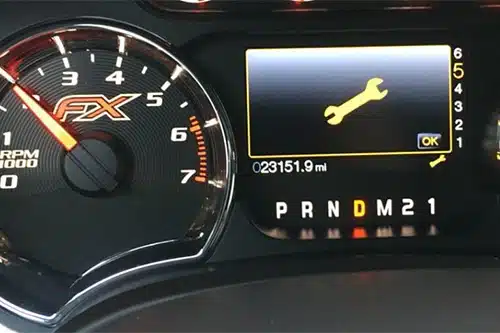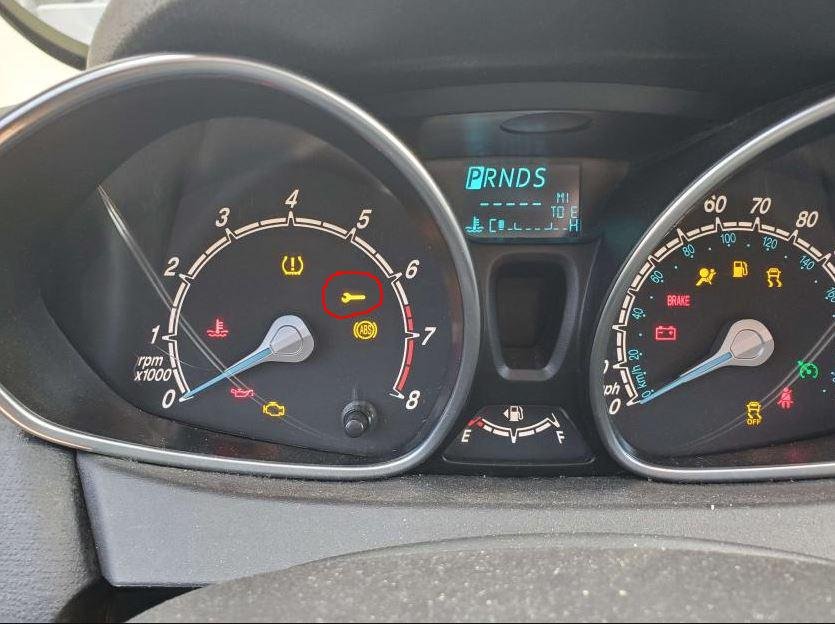The wrench light on a Ford indicates a problem with the powertrain or all-wheel-drive system. It requires immediate attention.
The wrench light is a crucial indicator on your Ford’s dashboard. It signals potential issues with the powertrain or all-wheel-drive system. Ignoring this warning can lead to serious mechanical problems. Addressing it promptly can prevent further damage and costly repairs.
Regular maintenance and timely diagnostics are essential to keep your vehicle running smoothly. Understanding the wrench light’s significance helps ensure your Ford’s longevity and reliability.
Always consult your owner’s manual or a professional mechanic when the wrench light appears. Taking immediate action ensures your safety and the optimal performance of your vehicle.

Credit: www.reddit.com
Meaning Of The Wrench Light
Seeing the wrench light on your Ford can be confusing. It is important to know what it means. This light is a signal that something is wrong. It could be a minor issue or something more serious. Understanding this light can help you take quick action.
Symbol Explanation
The wrench light is a yellow or amber symbol. It looks like a wrench on your dashboard. This light is part of your car’s onboard diagnostics system. It alerts you to potential issues with your vehicle.
When this light comes on, it indicates a problem with the powertrain or all-wheel-drive system. The powertrain includes the engine, transmission, and other components that deliver power to the wheels. This symbol is a warning to check your vehicle soon.
Common Triggers
The wrench light can be triggered by several issues. Here are some common triggers:
- Transmission problems
- Throttle control issues
- Powertrain malfunctions
- Low fluid levels
- Sensor failures
Transmission problems are one of the main triggers. This could be due to low transmission fluid or a failing transmission component. Throttle control issues can also cause the wrench light to come on. This affects how your vehicle accelerates.
Powertrain malfunctions might involve the engine or transmission. Low fluid levels in the engine or transmission can trigger the light. Sensor failures, such as those in the throttle position sensor, are also common.
| Trigger | Description |
|---|---|
| Transmission Problems | Issues with the transmission fluid or components |
| Throttle Control Issues | Problems affecting acceleration |
| Powertrain Malfunctions | Engine or transmission issues |
| Low Fluid Levels | Engine or transmission fluids are low |
| Sensor Failures | Throttle position sensor or other sensor issues |
Understanding these triggers can help you diagnose the problem. Make sure to address these issues promptly. This can prevent further damage to your vehicle.
Possible Causes
The wrench light on your Ford dashboard can be alarming. This light indicates a problem that needs attention. Understanding the possible causes helps diagnose the issue quickly.
Transmission Issues
One common cause of the wrench light is transmission issues. These problems can affect your car’s performance.
- Low transmission fluid
- Worn-out transmission components
- Faulty transmission sensors
Low transmission fluid can cause the light to appear. It is important to check the fluid level regularly. Worn-out components can also trigger the light. Regular maintenance helps prevent this. Faulty sensors can send incorrect signals. This might cause the light to turn on.
Throttle Problems
Another possible cause is throttle problems. The throttle controls the engine’s air intake.
- Dirty throttle body
- Faulty throttle position sensor
- Sticking throttle plate
A dirty throttle body can restrict air flow. This can cause the wrench light to turn on. A faulty throttle position sensor can send wrong signals. This might trigger the light as well. A sticking throttle plate can also cause problems. Regular cleaning can help avoid these issues.
Immediate Actions To Take
When you see the wrench light on your Ford’s dashboard, it signals a problem. Knowing the immediate actions to take can prevent further issues. Here’s a guide to help you address the wrench light effectively.

Credit: branchautomotive.com
Safety Precautions
Your safety comes first. Follow these steps:
- Find a safe spot to pull over immediately.
- Turn on your hazard lights.
- Engage the parking brake.
Ensuring the vehicle is in a secure location is crucial. This will prevent accidents and allow you to diagnose the issue safely.
Initial Diagnostics
Conducting initial diagnostics can help identify the problem. Here are some steps:
- Turn off the engine and wait for a few minutes.
- Restart the car to see if the light remains on.
- Check the dashboard for other warning lights.
If the wrench light stays on, it could indicate a transmission or throttle issue. Use an OBD-II scanner if available. This device can read error codes from your vehicle’s computer.
| Error Code | Possible Issue |
|---|---|
| P0700 | Transmission Control System |
| P2101 | Throttle Actuator Control Motor |
Identifying the error code helps you understand the problem better. It also aids in communicating with a mechanic.
Following these steps ensures your safety and helps in diagnosing the issue. Addressing the wrench light promptly can save you from costly repairs.
When To Seek Professional Help
Understanding the wrench light on your Ford is crucial. This light indicates potential issues needing immediate attention. Knowing when to seek professional help can prevent further damage and costly repairs.
Warning Signs
Several warning signs suggest it’s time to consult a mechanic. Pay attention to these indicators:
- Persistent wrench light after restarting the car.
- Unusual noises from the engine or transmission.
- Sudden changes in vehicle performance.
- Reduced fuel efficiency.
Ignoring these signs can lead to severe engine or transmission damage. Early detection is key to avoiding major problems.
Mechanic Consultation
When the wrench light stays on, a mechanic consultation becomes essential. A professional can diagnose the issue accurately. Here’s what to expect during your visit:
- Mechanic will check the car’s computer system.
- They will run diagnostic tests to identify the problem.
- Mechanic will provide a detailed report of findings.
- They will recommend necessary repairs or replacements.
Always seek a certified Ford technician. They have the expertise and tools to handle your vehicle efficiently. Regular maintenance checks can also help prevent future issues.
Diy Troubleshooting Tips
Seeing the wrench light on your Ford dashboard can be concerning. It may indicate a problem with the vehicle’s powertrain or throttle control. Before rushing to the mechanic, try these DIY troubleshooting tips to resolve the issue yourself.
Basic Checks
Start by performing these basic checks:
- Check your vehicle’s oil level. Low oil can trigger the light.
- Inspect the transmission fluid. Ensure it is at the correct level.
- Look at the air filter. A dirty air filter can affect performance.
Resetting The Light
If the wrench light remains, try resetting it:
- Turn off your vehicle and remove the key.
- Disconnect the negative battery terminal. Wait 15 minutes.
- Reconnect the battery terminal. Start your vehicle.
- Check if the wrench light is off. If not, repeat the steps.
These steps can help you diagnose and fix the issue. If the light stays on, seek professional help.

Credit: m.youtube.com
Preventive Maintenance
Understanding the significance of the wrench light on your Ford vehicle is crucial. This light often signifies the need for preventive maintenance. Regular care keeps your vehicle in top shape and avoids costly repairs.
Regular Servicing
Regular servicing is essential for your Ford’s longevity. Scheduled maintenance checks help identify potential issues early. Addressing problems before they escalate saves you time and money.
- Oil Changes: Keep the engine running smoothly.
- Tire Rotations: Ensure even tire wear and extend tire life.
- Brake Inspections: Maintain safe stopping power.
- Fluid Top-Ups: Prevent overheating and other issues.
Monitoring Vehicle Health
Monitoring your vehicle’s health helps avoid unexpected breakdowns. Using technology can simplify this task.
Many Ford vehicles come equipped with advanced diagnostics systems. These systems alert you to potential issues before they become serious. Pay attention to these alerts for optimal vehicle performance.
- Dashboard Indicators: Don’t ignore warning lights.
- Regular Inspections: Check under the hood monthly.
- Listen to Your Car: Unusual sounds can indicate problems.
Keep a maintenance log to track services and repairs. This record helps you stay on top of required maintenance tasks.
Understanding Your Ford’s Manual
Knowing what the wrench light means on your Ford is crucial. The wrench light can indicate many issues. Understanding your Ford’s manual helps you identify these problems. The manual is your best guide for maintaining your vehicle. It provides a wealth of information and tips.
Key Sections
Your Ford’s manual is divided into key sections. Each section serves a specific purpose. Here are some important sections:
| Section | Description |
|---|---|
| Introduction | Overview of your vehicle. |
| Dashboard Symbols | Explains all the dashboard lights. |
| Maintenance Schedule | Lists when to service your vehicle. |
| Troubleshooting | Helps diagnose common issues. |
Useful Tips
Here are some useful tips for understanding your manual:
- Always keep the manual in your car.
- Refer to the troubleshooting section if the wrench light is on.
- Follow the maintenance schedule to avoid issues.
- Learn the dashboard symbols to know what each light means.
- Use the index to find information quickly.
Understanding your Ford’s manual ensures your vehicle runs smoothly. It helps you address issues early and maintain your car effectively.

Credit: www.cargurus.com
Advanced Diagnostic Tools
Modern cars like Ford use advanced diagnostic tools. These tools help identify issues quickly. They assist in understanding the wrench light on your dashboard. Let’s explore these tools in detail.
Obd-ii Scanners
OBD-II scanners are essential for any Ford owner. They help in diagnosing car issues. These scanners connect to your car’s computer system. They read and report error codes. This makes it easier to understand what needs fixing.
OBD-II scanners come in various types:
- Handheld Scanners
- Bluetooth Scanners
- Professional Scanners
Each type has its own benefits. Handheld scanners are simple and user-friendly. Bluetooth scanners connect to your smartphone. Professional scanners offer detailed reports. Choose one based on your needs.
Reading Error Codes
Reading error codes is crucial. It helps you understand the problem. Follow these steps to read the codes:
- Plug the OBD-II scanner into the port under the dashboard.
- Turn on the car’s ignition but don’t start the engine.
- Wait for the scanner to connect and read the codes.
- Note down the codes displayed on the scanner.
Each code has a specific meaning. Refer to the scanner’s manual for code definitions. Common codes include:
| Code | Meaning |
|---|---|
| P0171 | System Too Lean |
| P0300 | Random Misfire Detected |
| P0420 | Catalyst System Efficiency Below Threshold |
Understanding these codes helps in quick fixes. It saves time and money. If unsure, seek professional help. Always keep your OBD-II scanner handy. It’s a valuable tool for every Ford owner.
Frequently Asked Questions
- What Does The Wrench Light Indicate?
The wrench light indicates a problem with the powertrain or transmission.
- Can I Drive With The Wrench Light On?
It’s best to avoid driving and seek professional help immediately.
- How Do I Reset The Wrench Light?
Resetting typically requires a diagnostic tool. Consult your mechanic.
- Is The Wrench Light A Serious Issue?
Yes, it signifies a serious issue needing immediate attention.
- What Causes The Wrench Light To Turn On?
Common causes include transmission issues, sensor failures, or engine problems.
Conclusion
Seeing the wrench light on your Ford can be concerning. It usually indicates maintenance or a minor issue. Always consult your owner’s manual for guidance.
Addressing it promptly ensures your vehicle runs smoothly. Regular maintenance can prevent future problems.
Keep your Ford in top shape by staying proactive.
Recent Posts
Maintaining clean gutters is essential for preventing water damage to your home, and choosing the best ladder for cleaning gutters can make the job much easier and safer. With so many options on the...
Best Ladder for Cleaning Caravan Roof: Top Picks for You Every Adventure!
Today we will discuss the best ladder for cleaning caravan roof. Cleaning caravan roofs is one of the crucial tasks.After many days, a caravan roof can get dirty by debris, dirt, and grime. These can...
